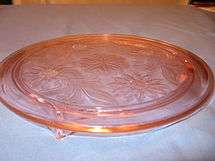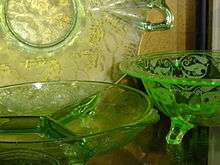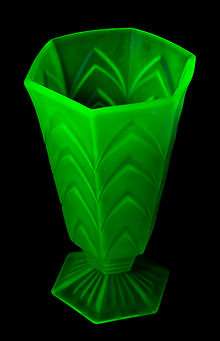Depression glass
Depression glass is clear or colored translucent machine made glassware that was distributed free, or at low cost, in the United States and Canada around the time of the Great Depression. Depression glass is called such because collectors generally associate mass-produced glassware found in pink, yellow, crystal, or green with the years surrounding the Great Depression in America.[1]



History
The Quaker Oats Company, and other food manufacturers and distributors, put a piece of glassware in boxes of food, as an incentive to purchase. Some movie theaters and businesses handed out pieces to patrons.
Most of this glassware was made in the Ohio River Valley of the United States, where access to raw materials and power made manufacturing inexpensive in the first half of the twentieth century. More than twenty manufacturers made more than 100 patterns, and entire dinner sets were made in some patterns. Common colors are clear (crystal), pink, pale blue, green, and amber. Less common colors include yellow (canary), ultramarine, jadeite (opaque pale green), delphite (opaque pale blue), cobalt blue, red (ruby and royal ruby), black, amethyst, monax, and white (milk glass). Some depression glass is uranium glass.
Although of marginal quality, Depression glass has been highly collectible since the 1960s. Due to its popularity as a collectible,[2] it is becoming more scarce on the open market. Rare pieces may sell for several hundred dollars. Some manufacturers continued to make popular patterns after World War II, or introduced similar patterns, which are also collectible. Popular and expensive patterns and pieces have been reproduced, and reproductions are still being made.
Manufacturers and patterns
|
|

Elegant glass
Often confused with Depression glass is Elegant glass, which is of much better quality. It was distributed through jewelry and department stores from the 1920s through the 1950s, and was an alternative to fine china. Most of the Elegant glassware manufacturers had closed by the end of the 1950s, when cheap glassware and imported china replaced Elegant glass.

Some Elegant glass manufacturers were:
- Cambridge Glass Company
- Consolidated Lamp and Glass Company
- Duncan Miller Glass Company
- Fenton Art Glass Company
- Fostoria Glass Company
- Heisey Glass Company
- Imperial Glass Company
- Lotus Glass Company
- McKee Glass Company
- Morgantown Glass Works
- New Martinsville Glass Company
- Paden City Glass Company
- Tiffin Glass Company
- Westmoreland Glass Company
See also
| Wikimedia Commons has media related to Depression Glassware. |
References
- Schroy, Ellen (2013). Depression Glass:Field Guide. Wisconsin: F+W Media, Inc. p. 5. ISBN 978-1-4402-3456-9.
- "Crescent City Depression glass show to be held in Kenner". The Times-Picayune. March 17, 2011. Retrieved March 17, 2011.
- http://www.hazelatlasglass.com